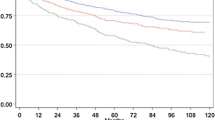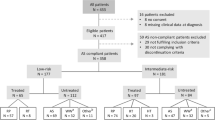Abstract
Purpose
A paucity of data exists on the insignificant disease potentially suitable for active surveillance (AS) among men with intermediate-risk prostate cancer (PCa). We tried to identify pathologically insignificant disease and its preoperative predictors in men who underwent radical prostatectomy (RP) for intermediate-risk PCa.
Methods
We analyzed data of 1,630 men who underwent RP for intermediate-risk disease. Total tumor volume (TTV) data were available in 332 men. We examined factors associated with classically defined pathologically insignificant cancer (organ-confined disease with TTV ≤0.5 ml with no Gleason pattern 4 or 5) and pathologically favorable cancer (organ-confined disease with no Gleason pattern 4 or 5) potentially suitable for AS. Decision curve analysis was used to assess clinical utility of a multivariable model including preoperative variables for predicting pathologically unfavorable cancer.
Results
In the entire cohort, 221 of 1,630 (13.6 %) total patients had pathologically favorable cancer. Among 332 patients with TTV data available, 26 (7.8 %) had classically defined pathologically insignificant cancer. Between threshold probabilities of 20 and 40 %, decision curve analysis demonstrated that using multivariable model to identify AS candidates would not provide any benefit over simply treating all men who have intermediate-risk disease with RP.
Conclusion
Although a minority of patients with intermediate-risk disease may harbor pathologically favorable or insignificant cancer, currently available conventional tools are not sufficiently able to identify those patients.

Similar content being viewed by others
References
Iremashvili V, Pelaez L, Manoharan M, Jorda M, Rosenberg DL, Soloway MS (2012) Pathologic prostate cancer characteristics in patients eligible for active surveillance: a head-to-head comparison of contemporary protocols. Eur Urol 62:462–468
Bul M, van den Bergh RC, Zhu X, Rannikko A, Vasarainen H, Bangma CH, Schröder FH, Roobol MJ (2012) Outcomes of initially expectantly managed patients with low or intermediate risk screen-detected localized prostate cancer. BJU Int 110:1672–1677
Godtman RA, Holmberg E, Khatami A, Stranne J, Hugosson J (2013) Outcome following active surveillance of men with screen-detected prostate cancer. Results from the Göteborg randomised population-based prostate cancer screening trial. Eur Urol 63:101–107
Cooperberg MR, Cowan JE, Hilton JF, Reese AC, Zaid HB, Porten SP, Shinohara K, Meng MV, Greene KL, Carroll PR (2011) Outcomes of active surveillance for men with intermediate-risk prostate cancer. J Clin Oncol 29:228–234
Van der Kwast TH (2012) The trade-off between sensitivity and specificity of clinical protocols for identification of insignificant prostate cancer. Eur Urol 62:469–471
Ahmed HU (2013) Prostate cancer: time for active surveillance of intermediate-risk disease? Nat Rev Urol 10:6–8
Mohler J, Kantoff PW, Armstrong AJ, Bahnson RR, Cohen M, D’Amico AV, Eastham JA, Enke CA, Farrington TA, Higano CS, Horwitz EM, Kawachi MH, Kuettel M, Lee RJ, Macvicar GR, Malcolm AW, Miller D, Plimack ER, Pow-Sang JM, Richey S, Roach M 3rd, Rohren E, Rosenfeld S, Small EJ, Srinivas S, Stein C, Strope SA, Tward J, Walsh PC, Shead DA, Ho M, National Comprehensive Cancer Network (2013) Prostate cancer, version 1.2014. J Natl Compr Cancer Netw 11:1471–1479
Reese AC, Pierorazio PM, Han M, Partin AW (2012) Contemporary evaluation of the National Comprehensive Cancer Network prostate cancer risk classification system. Urology 80:1075–1079
NCCN Clinical Practice Guidelines in Oncology (NCCN Guideline®). Prostate cancer v4.2013. http://www.nccn.org/professionals/physician_gls/pdf/prostate.pdf
Hong SK, Poon BY, Sjoberg DD, Scardino PT, Eastham JA (2014) Prostate size and adverse pathologic features in men undergoing radical prostatectomy. Urology 84:153–157
Udo K, Cronin AM, Carlino LJ, Savage CJ, Maschino AC, Al-Ahmadie HA, Gopalan A, Tickoo SK, Scardino PT, Eastham JA, Reuter VE, Fine SW (2013) Prognostic impact of subclassification of radical prostatectomy positive margins by linear extent and Gleason grade. J Urol 189:1302–1307
Epstein JI, Walsh PC, Carmichael M, Brendler CB (1994) Pathologic and clinical findings to predict tumor extent of nonpalpable (stage T1c) prostate cancer. JAMA 271:368–374
Wolters T, Roobol MJ, van Leeuwen PJ, van den Bergh RC, Hoedemaeker RF, van Leenders GJ, Schröder FH, van der Kwast TH (2011) A critical analysis of the tumor volume threshold for clinically insignificant prostate cancer using a data set of a randomized screening trial. J Urol 185:121–125
Ploussard G, Epstein JI, Montironi R, Carroll PR, Wirth M, Grimm MO, Bjartell AS, Montorsi F, Freedland SJ, Erbersdobler A, van der Kwast TH (2011) The contemporary concept of significant versus insignificant prostate cancer. Eur Urol 60:291–303
Lee MC, Dong F, Stephenson AJ, Jones JS, Magi-Galluzzi C, Klein EA (2010) The Epstein criteria predict for organ-confined but not insignificant disease and a high likelihood of cure at radical prostatectomy. Eur Urol 58:90–95
Steyerberg EW, Roobol MJ, Kattan MW, van der Kwast TH, de Koning HJ, Schröder FH (2007) Prediction of indolent prostate cancer: validation and updating of a prognostic nomogram. J Urol 177:107–112
Nakanishi H, Wang X, Ochiai A, Trpkov K, Yilmaz A, Donnelly JB, Davis JW, Troncoso P, Babaian RJ (2007) A nomogram for predicting low-volume/low-grade prostate cancer: a tool in selecting patients for active surveillance. Cancer 110:2441–2447
van den Bergh RC, Ahmed HU, Bangma CH, Cooperberg MR, Villers A, Parker CC (2014) Novel tools to improve patient selection and monitoring on active surveillance for low-risk prostate cancer: a systemic review. Eur Urol 65:1023–1031
Knezevic D, Goddard AD, Natraj N, Cherbavaz DB, Clark-Langone KM, Snable J, Watson D, Falzarano SM, Magi-Galluzzi C, Klein EA, Quale C (2013) Analytical validation of the Oncotype DX prostate cancer assay—a clinical RT-PCR assay optimized for prostate needle biopsies. BMC Genom 14:690
Acknowledgments
Supported by the Sidney Kimmel Center for Prostate and Urologic Cancers. Supported in part by funds provided by David H. Koch through the Prostate Cancer Foundation. Supported in part by NIH/NCI Cancer Center Support Grant to MSKCC under award number P30 CA008748.
Author information
Authors and Affiliations
Corresponding author
Rights and permissions
About this article
Cite this article
Hong, S.K., Vertosick, E., Sjoberg, D.D. et al. Insignificant disease among men with intermediate-risk prostate cancer. World J Urol 32, 1417–1421 (2014). https://doi.org/10.1007/s00345-014-1413-3
Received:
Accepted:
Published:
Issue Date:
DOI: https://doi.org/10.1007/s00345-014-1413-3




